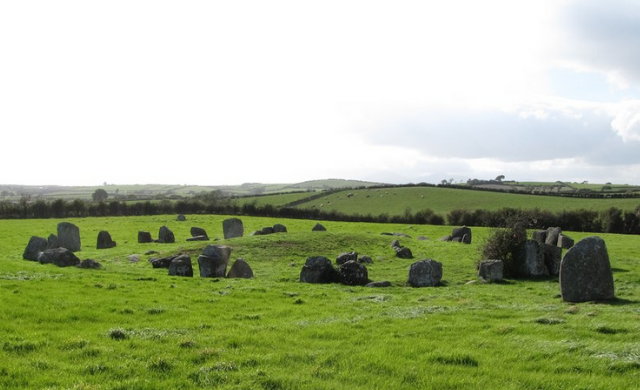Ballynoe Stone Circle

Ballynoe Stone Circle, the earliest and the largest Megalithic Structure surviving in Ulster Photo © Eric Jones (cc-by-sa/2.0)
Just a few miles inland can be found a large and impressive circle of 100 feet in diameter with more than closely spaced unhewn 50 monoliths of Silurian rock or granite. The largest, 6.5 feet high and 3 feet thick. Within is a smaller incomplete elliptical circle [90 feet by 40 ft.].
According to tradition, two or more circles surrounded the present one, but as the stones interfered with the cultivation of the land they were removed, and several outlying monoliths in the fields adjoining seem to confirm this tradition.
A Cryptic Formation
A puzzling feature of some of the great stones is the occurrence of round small like depressions. They now hold rainwater but in bygone ages when pagan rites were performed here. One can ask what did these holes held then?
An oval Bronze Age mound inside the circle was excavated in 1937-38. Two rectangular graves were found with cremated bones. Gathered around the long mound, the stones have a rather human air, as if they had come to wonder at the grave of a dead giant.
How or why these stone circles, of which there are numerous examples in Cork, Kerry, and Wicklow. In Brittany, in France and as far north as Northern Scotland, ever came to be erected is a matter merely for speculation, even among archaeologists.
The popular belief, however, is that Neolithic man first built it as a communal temple and a place of worship. It became a burying place of persons of great importance much later.
Here as I said this mysterious prehistoric monument where our vivid imagination can exercise itself boundlessly as to their purpose.
Stone Purpose
On your visit here you will note that one stone is taller than the rest whilst another opposite is lying flat ; occasionally a line is drawn between these two, then continued to the horizon, can lead the eye to some notable geographically feature where the sun may be seen or set on some particularly significant day of the year – [equinox, solstice etc.] . This might suggest that these stone circles may have been set up to mark significant solar events. In reality, all that would have been required to do so would have been two stones – and an eye to draw the line between them and continue it.
But much more must have been involved than the recording of important events in the solar calendar. The round form must surely have been created as a place of ritual.
The custom of building stone circles continued throughout the Bronze Age and as late as the Iron Age. During which a burial like here at Ballynoe was inserted at the centre of the circle.
Our Ulster Stonehenge in many ways resembles the more famous one in Salisbury Plains. The latter’ circle of stones is also 100 feet in diameter with an inner circle.
Ballkynoe Stone circle can be reached on foot by a lane, opposite what was the old Ballynoe railway station.
Surrounding Castles
Half mile to the west is a rath surrounded by a deep water-filled fosse, with a rampart some 30 feet high in places. Another half mile further is the ruins of CASTLE SKRENE, a former 12th century home of the feudal Lord De Courcy, on a hill which commands an extensive view of the surrounding countryside.
Near Ballynoe is the ancient Well of St. Finnian in the townland that is called Erynach where once stood The Abbey of Carrick. On a white portion of the rock above the well, is still to be seen what is said to be, the print of the Saint’s knee and feet. The monastery here was destroyed by De Courcey.
Two miles east of Ballynoe is the townland of Bright wherein 1782 was founded the first Sunday school in Ireland. Not much of BRIGHT CASTLE is still standing except a wall fronting the country road and a few stones on either side. But this gable wall with its scars from time and war carries a threat to two people. –if they are suspicious. The trouble is – who are the two? ‘’a woman and a man’ – will meet a violent end when the castle wall will fall on them.
SKRENE and BRIGHT’S CASTLE was built to guard the pass between two important towns. Ardglass and Downpatrick.
For years the longest golf hole in Ireland was the 590 yards sixth at Portmarnock. Not any more. Now that long sized label belongs to the 16th at Bright Castle. A massive 650 yards off the championship tee. It would probably boast a par-rating six if the designer and owner Arnold Ennis had his way.
J.J. Tohill
More from Happy Ireland
If you enjoyed this blog, click here to view more from us!
With Happy Ireland Productions, you can preserve your memories to last forever. Visit one of our partners to drop off your assortment of tapes, film, pictures and audio keepsakes. You’ll receive your DVD or digital copy with the original. Simple and Safe!
Your memories are priceless so why risk losing them.
Learn more about Happy Ireland Productions or Contact us for any inquiries